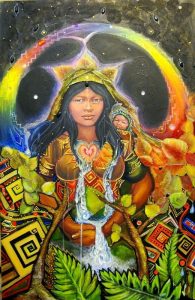
Pachamama, by Eva Ruiz.
Pachamama is an Incan fertility goddess who is still worshipped by several indigenous tribes in the Andes. She’s also known as ‘Mother Nature’, ‘Earth Mother’ and ‘Time Mother’ and is seen with a primordial feminine image. In Incan mythology, she was a dragon deity, who presided over the harvests. She lived in the mountains and personified the earth alongside her husband Inti, the sun god. Pachamama is still believed to be a present force by some, who can cause earthquakes if she is displeased. Originally her priests would have sacrificed llamas and guinea pigs to appease her, as well as buried miniature burned garments at her rock altars. She was believed to be cruel if they did not, as she was eager to collect her sacrifices. However, in modern culture she is benevolent and is a local representation of ‘Mother Nature’. As the deity of agriculture, the Incans would hold daily small rituals in her honour during both the planting and the harvest. During this ritual, the women would walk through the fields whispering their thanks, and pouring a small handful of cornmeal onto the ground.
Following the Spanish Conquest of the Incan Civilisation, or ‘Tawantinsuyu’ in approximately 1533, many countries were forced to convert to Catholicism. This resulted in Pachamama becoming synonymous with the Virgin Mary for many indigenous people; a belief which is still held by some today. Many rituals related to the Pachamama are practiced in conjunction with those of Christianity, to the point that many families are simultaneously Christian and pachamamistas.
The Quechua peoples believe Pachamama is the origin of their four principles; water, earth, sun and moon. Their region stretches across a large amount of the central Andes, covering Bolivia, Ecuador, Chile, Peru and Argentina. Here she is known to all as ‘Good Mother’, with people toasting to her honour in a ritual known as ‘challa’. Many believe that problems arise when they take too much from nature, as they are taking too much from Pachamama. Many countries also celebrate ‘Martes de challa’ or ‘Tuesday of challa’, dedicated to Pachamama. This is where beer is thrown onto the ground to appease the goddess, and ensure she provides a good coming harvest. Cleansing rituals are also performed, where plants or wood are burnt in order to scare away any lingering evil spirits.
While modern rituals take place throughout the year, they’re still particularly common before the sowing season in order to secure a sufficient food supply, and again in August. As this is the coldest month in the Andes, her followers believe this will keep themselves and their crops healthy through the winter. On the night before 1st August, families prepare to honour her by cooking all night. The host then makes a hole in the ground and if the soil comes out nicely, this means that it will be a good harvest year. Before any of the guests sit down to eat, the host must first give a plate to Pachamama. This is poured onto the ground and a prayer is recited.
A Pachamama Festival is also held, with a Sunday Parade. As part of this, the organizational committee of the festival searches for the oldest woman in the community and elects her the “Pachamama Queen of the Year.” Indigenous women, in particular senior women, are seen as living symbols of wisdom, life and reproduction. The elected Pachamama queen is escorted to the parade and is then saluted. Tourists visiting sites such as Machu Picchu and Cusco are offered the chance to participate in ritual offerings to Pachamama.
-Devon Allen
Junior Girl
Girl Museum Inc.
